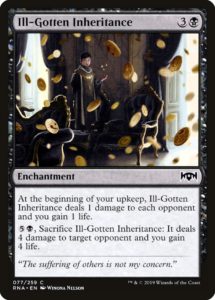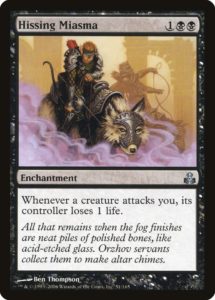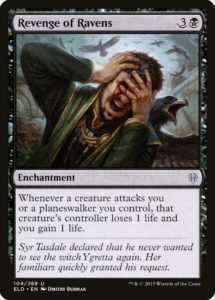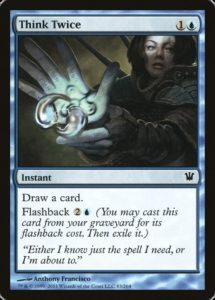Teferi’s Tutelage has drastically overpowered for me in Core Set 2021 draft. It clearly follows in the footsteps of Psychic Corrosion and Sphinx’s Tutelage, but its immediate minor benefit coupled with the low power of the format makes it far stronger than its forebears in Limited. And it got me thinking about other uncommon enchantments that were both surprisingly potent and painfully inevitable.
One doesn’t have to go back too far to find a four mana black enchantment with a similar profile.
No, not that one. Ill-Gotten Inheritance was another surprisingly excellent card, iterating on mostly lackluster previous designs to produce a game-winning effect. In fact, it was so well known for being good despite seeming bad, we probably shouldn’t have missed out on Revenge of Ravens or Sanctum of Stone Fangs (which seems like a terrible place to seek peace).
Magic has plenty of rattlesnake-type cards that discourage attacking. Hissing Miasma, Marchesa’s Decree, Blood Reckoning, Circle of Flame, Raking Canopy, and perhaps the oldest of them all, Barbed Foliage all punish attackers with damage, either to them or their controller. Other effects include Righteous Cause, Ever-Watching Threshold, and Teferi’s Veil, not to mention on-damage cards like Dissipation Field and Angelheart Vial. But outside of Lost in the Woods, none of these cards were much good in draft.
Rattlesnake effects are defensive cards which only function if your opponent cooperates by attacking you. If it’s too painful for them to attack, they just won’t. Tribute and Rhystic are great examples of why putting a card’s power in your opponent’s hands make them weaker. Effects like Blood Reckoning are especially suspect, since they only function if you’re pressuring your opponent’s life total. But if dealing lots of damage to your opponent is the goal, why on earth are you playing a four mana defensive enchantment rather than another creature?
The magic of Revenge of Ravens, just as it was with Ill-Gotten Inheritance, is that two minor synergistic effects are often better than one equivalent moderate effect. Draining one life is the same total life swing as dealing or gaining two life, but combining the two blunts your opponent’s offense while enabling yours. (It also likely keeps cost low—a Hissing Miasma that caused two life loss likely wouldn’t cost four mana.)
Revenge of Ravens effectively renders all one-power attacking creatures useless and all two-power attacking creatures mostly useless. If your opponent is at a relatively low life total and you are not, it effectively kills them (unless you’re in danger of decking, they have a lifelinker or enchantment removal, or an alternate win condition is in play). But rather than actually killing them, it inflicts the slow realization of inevitable failure.
I’ve certainly experienced and inflicted that hopelessness—my life total was too high for anything short of a massive creature to do relevant damage and a single Venture Deeper meant that opponent would deck before I did. That’s not a very fun play pattern and one Magic is cautious about enabling, but it’s worth recognizing that every now and then it’s good for prison effects to exist. Sure, more people despise prison cards than love them, but there are people who love them. Magic probably may be better off with cards like Trinisphere, Stasis, Blood Moon, and Chalice of the Void relegated to nonrotating formats, yet it’s interesting that Magic can sneak a potent prison card into Limited without much issue.
There’s a lot to learn from initially unassuming cards like Revenge of Ravens. Just because an effect has been poor in the past doesn’t mean an improved expression will be similarly poor. That context and slight differences separate power from filler. That combining effects can make them more than the sum of their parts. That a decision being put into your opponent’s hands might not be as painful if it’s a decision they must make (it’s quite difficult to win most games of Limited without attacking). That even more niche audiences, like prison and lockout card lovers, ought to get a bone sometimes—in Limited in addition to Constructed. And that ravens do indeed remember who wrongs them.
—Zachary Barash is a New York City-based game designer and the commissioner of Team Draft League. He designs for Kingdom Death: Monster, has a Game Design MFA from the NYU Game Center, and does freelance gatame design. When the stars align, he streams Magic (but the stars align way less often than he’d like).





